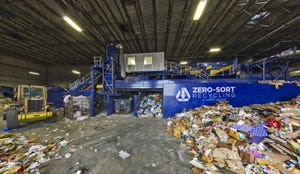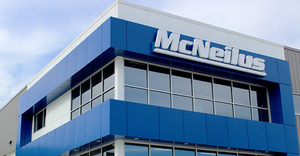Spec'ing Trucks for Safety
March 1, 2001
Bob Deierlein
Closer government scrutiny, more inexperienced drivers in the workforce, the cost of covering accident scenes, and vehicle recovery and repair are just some of the factors that keep safe driving in the spotlight. Loss or injury of a co-worker also is an important factor.
Safety is important — and can cut vehicle downtime. A total of 43,000 trucks and buses were inspected during the Commercial Vehicle Safety Alliance (CVSA) International Roadcheck 2000 in June; 20,781 of the vehicles received out-of-service violations, and more than 26 percent were placed out-of-service. On the other hand, 25,000 vehicles were found free of critical defects.
For the safest operation of a vehicle in waste fleets, specs must be selected for efficiency and a vehicle's ability to meet its operational needs. Efficient maintenance is just as important; however well specified, these components won't always continue to do the job unless they are maintained properly.
While brakes certainly are a very important factor in waste and recycling services and all accident-free driving, vision, in fact, is key to knowing when to use the brakes.
Research shows that 90 percent of all driving decisions are based on vision alone, so windshields, wipers, lights and especially mirrors are of increasing importance. (It is estimated that 25 percent of trucks on the road have ineffective windshields.)
After the proper original equipment specs for the job, many additional products or components are available to increase safe vehicle operation.
Of course, while safety should be considered an investment and not an expense, safety systems are expensive. It's difficult to set a price on many of the safety features that can be specified into a new truck, but those that appear in a dealer parts book can be costly.
For example, a set of motorized, lighted and heated dual West Coast-style mirrors — which are easier to adjust than manual mirrors and are resistant to ice and fogging — is listed as an option by one original equipment manufacturer (OEM) for more than $900. Non-motorized, non-heated mirrors cost about $75.
Avoiding Collisions
“Ninety percent of all driving decisions are based on vision alone, so windshields, wipers, lights and especially mirrors are of increasing importance.”
The primary goal of most of the latest accident avoidance technology, called supplemental information devices (SIDs), is to increase a driver's knowledge of the area surrounding the vehicle and warn him or her of potential collisions. The ultimate goal is 360-degree vision. However, one of the most critical blind-spots extends from the fuel tank to approximately 4 feet in front of the vehicle.
Electronic technology has produced a variety of collision warning systems (CWSs), which are designed to provide drivers with extra seconds in which to react to unexpected objects.
The idea that collision warning systems make for safer truck operation has, for a long time, been based largely on anecdotal evidence. Now, after more than three years of data on more than 1,900 vehicles, the results indicate that vehicles equipped with one brand of warning system, the Eaton VORAD EVT-300 CWS, are safer than those without the system. The company reports an overall accident reduction of 78 percent.
Other highlights of the data, which covered eight fleets in a variety of applications, include:
One fleet cut rear-end and lane-change accidents from 0.33 per million miles traveled to zero;
Another fleet reduced fixed-object accidents by 81 percent;
A third fleet reduced lane-change accidents by 80 percent in 1998. The following year that number was reduced by 76 percent; and
Finally, a different fleet with this equipment was involved in only 14 rear-end and lane-change accidents in 1999, vs. 264 similar incidents in the company's other trucks.
Onboard Safety Systems
Other on-vehicle safety systems that enhance the driver's ability to recognize potential hazards include:
High-intensity exterior lights that allow greater forward visibility at night, automated backup lights and alarms, and light-emitting diode (LED) lighting for all other illumination needs.
Vision systems that supplement the truck's mirror and window visibility by assisting in lane changes, turns and backing, and miniature video cameras strategically located on the truck's outside that provide live images on driver monitors.
Infrared night-vision systems that display a temperature-based view of objects beyond the headlights, giving drivers the ability to literally see in the dark.
Lane position monitors that detect out-of-lane drift and driver fatigue.
Electronic shock absorbers and rollover protection systems that optimize vehicle ride without compromising stability.
System monitoring, tire pressure, brake wear, wheel-end heat, driveline torsional vibrations and data logging.
Mirrors
Several trends in mirrors are developing. One is OEMs that are single-sourcing with companies that can supply all types of mirror systems. Another is a fleet “backlash” against proprietary mirror systems. Some complaints about mirrors that fleets cannot spec off a truck include wind noise, vibration of heavier mirrors that is tough on brackets and doors, and accumulation of dirt and grime on the mirror surface.
One of the biggest visibility improvements is a drastic change in the traditional mirror systems. For years, the West Coast mirror with an 8-inch convex mirror mounted directly under it, was the standard. Now, a large number of new trucks come equipped with an aerodynamic, remote-control, motorized and heated mirror with a multiple convex glass curvature housed in its lower section.
One supplier with a full line of mirrors, Lang Mekra North America, Ridgeway, S.C., points to advancements in its designs: improved breakaway mirror system brackets to minimize damage to the door or cab when impacted, which adjusts easily for maneuvering through narrow spaces; 4-way, remote-control, adjustable main and convex glass, a safety enhancement for enlarging range of vision and reducing blind spots; heated glass; and proprietary mirrors designed for specific trucks.
Looking ahead, the company sees further safety enhancing technology, including the use of dimmable glass, multiplexing, memory-system mirrors and the integration of information display and turn signals into mirror systems.
Another supplier, KAM Truck Components, Holland, Mich., offers a 4-way mirror, which is a West Coast-style dual-axis motorized mirror that allows the driver to view curbs and rear wheels. A driver can quickly spot tire and brake problems, and even view axle placement when on the scales.
Industry surveys show that glare can be a big problem. KAM's Glarestopper mirror has a patented electrochemical coating that darkens the mirror as light hits it, when an electrical current is introduced. Adding flat and convex mirrors to reduce blind spots can help.
There's even a blind-spot mirror for cab-over or conventional units to attach on the right front fender, which eliminates the blind spot from the corner of the unit all the way to the back.
Some drivers even put these mirrors on both sides of the truck so they won't have to take their eyes off the road.
One product, Toledo, Ohio-based Dana Corp.'s Moto Mirror Plus remote control mirror, combines a flat-glass mirror that moves in four directions and a convex mirror that rotates out with the flat glass. The rotating convex mirror provides 20 times more wide-angle vision in tight right turns than a standard fixed position convex mirror.
Also, Muth Mirror Systems, Sheboygan, Wis., has introduced Signal Mirrors for heavy trucks that use high-intensity lights to change ordinary West-Coast-style mirrors. When a turn signal is activated, a flashing chevron appears in the corresponding side mirror to alert drivers in the blind spot.
LED Lights
Protective prevention could be called the reason that many fleets are now specifying light-emitting diode (LED) marker and stop/tail/turn (s/t/t) lights on trucks and trailers because these lights make vehicles more visible to others during lane changes. LEDs provide instantaneous and brighter illumination compared to incandescents — and use less power.
Some other benefits of the reduced draw include increased fuel mileage from fewer loads being placed on the alternator and extended battery life with the lights on and the engine off.
“It would not be unusual for a single LED light to last the lifetime of a truck.”
Many OEMs concur and are incorporating LEDs on newer models. For example, Peterbilt, Denton, Texas, is offering LED marker lights on its Model 387. The company says that LED lights have numerous benefits over traditional incandescent bulbs. First, LEDs live seven times longer than the average incandescent lamp, and virtually are impervious to extreme temperatures and vibrations that could incapacitate incandescent lamps. It would not be unusual for a single LED light to last the lifetime of a truck.
Now, lighting suppliers are offering two new products. First, Dialight Corp., Manasquan, N.J., now offers a red 4-inch-round LED s/t/t signal that is available in 12 or 14 volts and contains 10 LEDs. The new 44 Series features a single-piece, potted sealing design that eliminates the weld that normally attaches the lens to the base. This removes a major potential failure point.
Truck-Lite, Falconer, N.Y., has announced a Model 26 LED sealed marker clearance lamp designed for cab, body and trailer marker applications. It is available in red and amber, and is hard-wired with blunt cut wires, making it ready for any terminal requirements.
Bob Deierlein is Waste Age's truck editor.
You May Also Like


